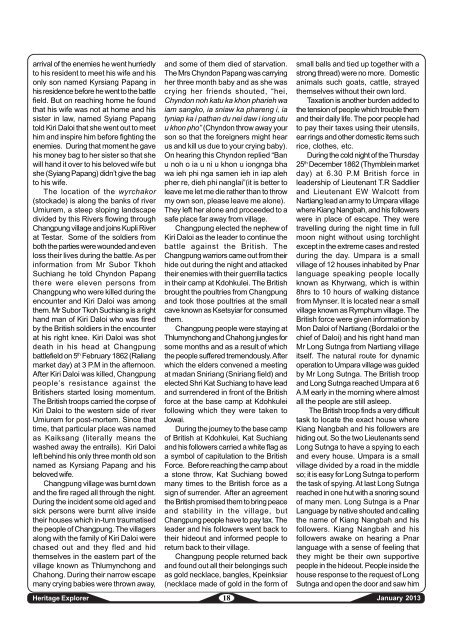You also want an ePaper? Increase the reach of your titles
YUMPU automatically turns print PDFs into web optimized ePapers that Google loves.
arrival of the enemies he went hurriedlyto his resident to meet his wife and hisonly son named Kyrsiang Papang inhis residence before he went to the battlefield. But on reaching home he foundthat his wife was not at home and hissister in law, named Syiang Papangtold Kiri Daloi that she went out to meethim and inspire him before fighting theenemies. During that moment he gavehis money bag to her sister so that shewill hand it over to his beloved wife butshe (Syiang Papang) didn’t give the bagto his wife.The location of the wyrchakor(stockade) is along the banks of riverUmiurem, a steep sloping landscapedivided by this Rivers flowing throughChangpung village and joins Kupli Riverat Testar. Some of the soldiers fromboth the parties were wounded and evenloss their lives during the battle. As perinformation from Mr Subor TkhohSuchiang he told Chyndon Papangthere were eleven persons fromChangpung who were killed during theencounter and Kiri Daloi was amongthem. Mr Subor Tkoh Suchiang is a righthand man of Kiri Daloi who was firedby the British soldiers in the encounterat his right knee. Kiri Daloi was shotdeath in his head at Changpungbattlefield on 5 th February 1862 (Raliangmarket day) at 3 P.M in the afternoon.After Kiri Daloi was killed, Changpungpeople’s resistance against theBritishers started losing momentum.The British troops carried the corpse ofKiri Daloi to the western side of riverUmiurem for post-mortem. Since thattime, that particular place was namedas Kaiksang (literally means thewashed away the entrails). Kiri Daloileft behind his only three month old sonnamed as Kyrsiang Papang and hisbeloved wife.Changpung village was burnt downand the fire raged all through the night.During the incident some old aged andsick persons were burnt alive insidetheir houses which in-turn traumatisedthe people of Changpung. The villagersalong with the family of Kiri Daloi werechased out and they fled and hidthemselves in the eastern part of thevillage known as Thlumynchong andChahong. During their narrow escapemany crying babies were thrown away,and some of them died of starvation.The Mrs Chyndon Papang was carryingher three month baby and as she wascrying her friends shouted, “hei,Chyndon noh katu ka khon pharieh waiam sangko, ia sniaw ka phareng i, iatyniap ka i pathan du nei daw i iong utuu khon pho” (Chyndon throw away yourson so that the foreigners might hearus and kill us due to your crying baby).On hearing this Chyndon replied “Banu noh o ia u ni u khon u iongnga bhawa ieh phi nga samen ieh in iap alehpher re, dieh phi nanglai”(it is better toleave me let me die rather than to throwmy own son, please leave me alone).They left her alone and proceeded to asafe place far away from village.Changpung elected the nephew ofKiri Daloi as the leader to continue thebattle against the British. TheChangpung warriors came out from theirhide out during the night and attackedtheir enemies with their guerrilla tacticsin their camp at Kdohkulei. The Britishbrought the poultries from Changpungand took those poultries at the smallcave known as Ksetsyiar for consumedthem.Changpung people were staying atThlumynchong and Chahong jungles forsome months and as a result of whichthe people suffered tremendously. Afterwhich the elders convened a meetingat madan Sniriang (Sniriang field) andelected Shri Kat Suchiang to have leadand surrendered in front of the Britishforce at the base camp at Kdohkuleifollowing which they were taken toJowai.During the journey to the base campof British at Kdohkulei, Kat Suchiangand his followers carried a white flag asa symbol of capitulation to the BritishForce. Before reaching the camp abouta stone throw, Kat Suchiang bowedmany times to the British force as asign of surrender. After an agreementthe British promised them to bring peaceand stability in the village, butChangpung people have to pay tax. Theleader and his followers went back totheir hideout and informed people toreturn back to their village.Changpung people returned backand found out all their belongings suchas gold necklace, bangles, Kpeinksiar(necklace made of gold in the form ofsmall balls and tied up together with astrong thread) were no more. Domesticanimals such goats, cattle, strayedthemselves without their own lord.Taxation is another burden added tothe tension of people which trouble themand their daily life. The poor people hadto pay their taxes using their utensils,ear rings and other domestic items suchrice, clothes, etc.During the cold night of the Thursday25 th December 1862 (Thymblein marketday) at 6.30 P.M British force inleadership of Lieutenant T.R Saddlierand Lieutenant EW Walcott fromNartiang lead an army to Umpara villagewhere Kiang Nangbah, and his followerswere in place of escape. They weretravelling during the night time in fullmoon night without using torchlightexcept in the extreme cases and restedduring the day. Umpara is a smallvillage of 12 houses inhabited by Pnarlanguage speaking people locallyknown as Khyrwang, which is within8hrs to 10 hours of walking distancefrom Mynser. It is located near a smallvillage known as Rymphum village. TheBritish force were given information byMon Daloi of Nartiang (Bordaloi or thechief of Daloi) and his right hand manMr Long Sutnga from Nartiang villageitself. The natural route for dynamicoperation to Umpara village was guidedby Mr Long Sutnga. The British troopand Long Sutnga reached Umpara at 6A.M early in the morning where almostall the people are still asleep.The British troop finds a very difficulttask to locate the exact house whereKiang Nangbah and his followers arehiding out. So the two Lieutenants sendLong Sutnga to have a spying to eachand every house. Umpara is a smallvillage divided by a road in the middleso; it is easy for Long Sutnga to performthe task of spying. At last Long Sutngareached in one hut with a snoring soundof many men. Long Sutnga is a PnarLanguage by native shouted and callingthe name of Kiang Nangbah and hisfollowers. Kiang Nangbah and hisfollowers awake on hearing a Pnarlanguage with a sense of feeling thatthey might be their own supportivepeople in the hideout. People inside thehouse response to the request of LongSutnga and open the door and saw him<strong>Heritage</strong> Explorer 18 January 2013




